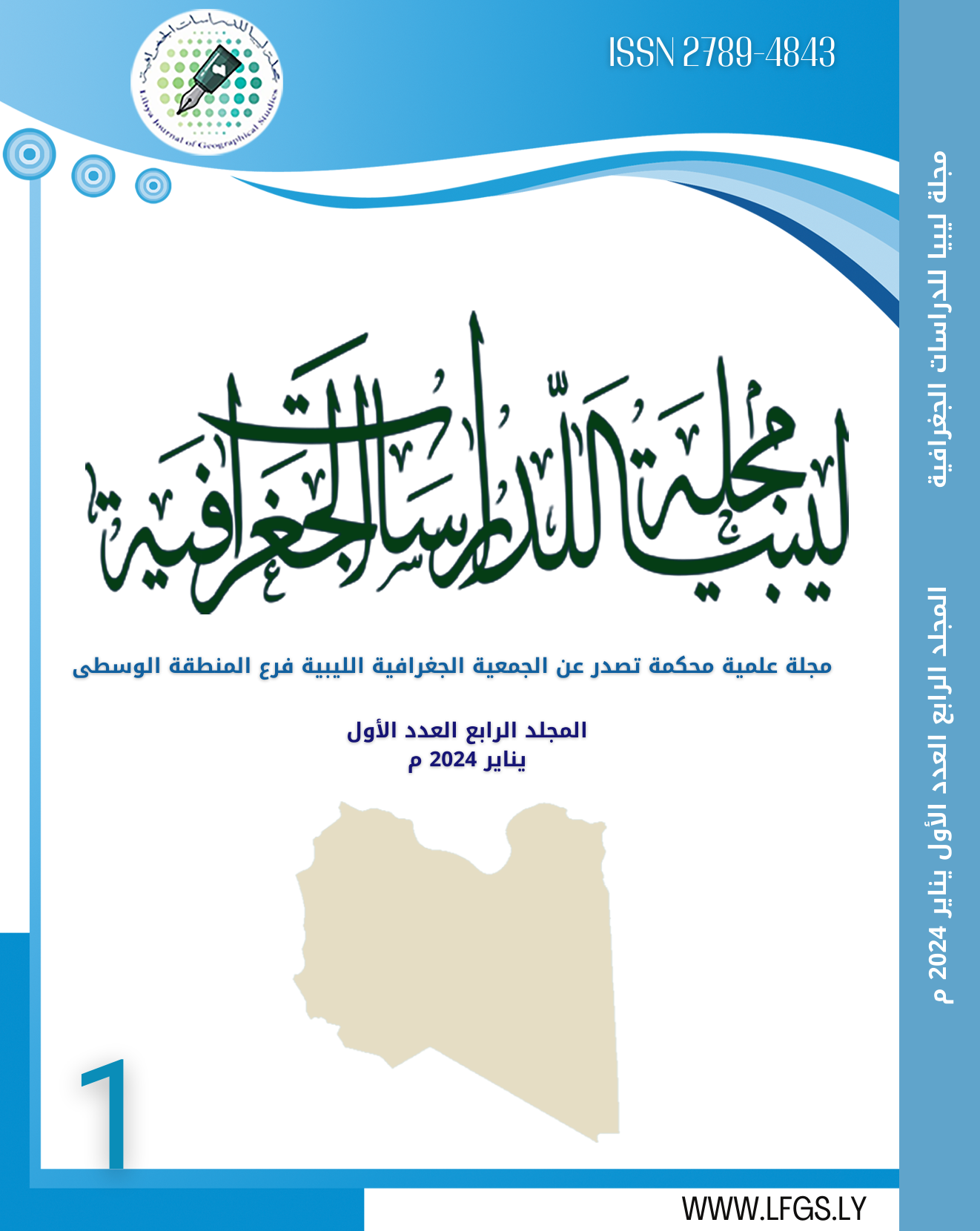Demographic Dimensions of the Italian Occupation of Libya " Study in Historical Demography
DOI:
https://doi.org/10.37375/jlgs.v4i1.2554Keywords:
demographic dimensions, population size development, demographic colonization, gender ratioAbstract
The study dealt with the demographic dimensions of the Italian occupation of Libya. The study aimed to identify the impact of wars on population growth and to know the change in the size of the population in the country and at the level of the three historical regions, and also to know the demographic colonial policy that Italy followed in the settlement operations. The study followed the historical approach and the descriptive analytical approach. The quantitative method to explain the phenomenon is under study, and I concluded that Italian colonialism had negative effects on the Libyan population, as it hindered its development and contributed to its demographic delay. It also explained that there is a regional disparity in the development of population size between the regions, and that the regions of Tripoli and Fezzan were slowly increasing. While Cyrenaica had the lion's share of this negative impact on the development of its population mass due to the continuation and length of the resistance period, which made its mass decline demographically and recorded a negative population decline that reached its peak during the period (1923-1929), recording about (-40,000) people, and the population growth rate reached about 1.04%, for the period (1911-1931), while the rate rose to record about 3.6% for the period (1954-1964). It was also shown that due to the colonial demographic policy, the numbers of Italian settlers developed and their numbers rose from about 19 thousand people in 1921 to about 115 thousand people in the year. 1936, to constitute about 13.6% of the total population, and then their numbers rose to 122 in 1940. The Italian occupation contributed to the imbalance in the gender ratio among the younger groups of the population, and the most imbalanced of these age groups is the age group (20-24) years.
References
أولاً: المراجع العربية:
- أبوعيانة، فتحي محمد، (2000) جغرافية السكان، أسس وتطبيقات، دار المعرفة الجامعية، الإسكندرية.
- بوذينة، يوسف، دواودة، محمود، (2020)، مجتمع ولاية طرابلس الغرب في العهد العثماني الثاني 1935-1911، رسالة ماجستير غير منشورة، قسم التاريخ، كلية العلوم الإنسانة والاجتماعية، جامعة يحي فارس المدية.
- توني، واي تي، سكان برقة إيضاحات جغرافية، من كتاب قراءات في سكان ليبيا (2014)، "تحرير" حسني بن زابيه، دار الفضيل للنشر والتوزيع، بنغازي.
- حمدان، جمال (1996)، الجماهيرية العربية الليبية الشعبية الاشتراكية دراسة في الجغرافيا السياسية، مكتبة مدبولي، القاهرة.
- الخفيفي، الصالحين جبريل محمد (2000)، النظام الضريبي في ولاية طرابلس الغرب (1835-1912)، مركز جهاد الليبيين، طرابلس.
- الرهيبي، عامر سالم، (1964)، تحليل وتقييم تعداد 1954 السكان الوطنيين، المركز الديموغرافي، القاهرة.
- زمو، سالم يوسف، (1985)، منطقة طرابلس دراسة السكان جغرافيا وديموغرافيا حتى عام 1980، "رسالة ماجستير غير منشورة"، قسم الجغرافيا، كلية الآداب، جامعة طرابلس.
- شرف، عبد العزير طريح، (1971)، جغرافية ليبيا، منشاة المعارف، الإسكندرية، ط 2.
- شعبة السكان بالأمم المتحدة، https://population.un.org/
- عطية، شوقي، (2017)، علم السكان في البحث التطبيقي والإحصائي، دار نلسن، 2017.
- العيسوي، فايز محمد، (2006) أسس جغرافية السكان، دار المعرفة الجامعية، الإسكندرية.
- فرحات، على احمد حسن، (2021)، سكان ليبيا بين 5 فبراير 1943 -24 ديسمبر 1951، مجلة البحوث الأكاديمية (العلوم الإنسانية)، العدد 20.
- القزيري، سعد خليل، (2021)، الحاجة لسياسات حضرية لحل مشاكل إقليمية " دراسة حالة إقليم الميزوجورنو"، من كتاب " سياسات حضرية"، دار ومكتبة الفضيل للنشر والتوزيع، بنغازي.
- مركز التطوير الاقتصادي، التقرير الوطني الأول عن حالة السكان في ليبيا 2010، طرابلس 2010.
- المملكة الليبية، وزارة الاقتصاد الوطني، مصلحة الإحصاء والتعداد، التعداد العام للسكان 1954.
- المملكة الليبية، وزارة الاقتصاد والتجارة، مصلحة الإحصاء والتعداد، التعداد العام للسكان.
- المهدوي، محمد المبروك، (1998)، جغرافية ليبيا البشرية، منشورات جامعة بنغازي.
- الهمالي، محمد إبراهيم (2021)، النافذة الديموغرافية الليبية دراسة في فرص الظهور والاستفادة منها، المجلة العالمية، كلية التربية المرج، جامعة بنغازي، العدد 51.
- الهمالي، محمد إبراهيم (2022)، الانتقال الديموغرافي في ليبيا "العوامل المؤثرة فيه وآثاره"، المؤتمر الجغرافي السادس عشر للجمعية الجغرافية الليبية، قسم الجغرافيا، كلية الآداب، جامعة طبرق، تحرير سميرة العياطي وآخرون.
- وسار، صلاح (2021)، ليبيا خلال الحرب العالمية الثانية 1939-1945، رسالة ماجستير غير منشورة، كلية العلوم الاجتماعية والإنسانية، جامعة العربي بن امهيدي- أم البواقي.
- ويكبيديا https://ar.wikipedia.org
ثانياً: المراجع الأجنبية:
- British Foreign Office, Italian Libya, Handbooks Prepared Under the Direction of the Historical Section of the Foreign Office—No. 127, London: Published by H. M. Stationery Office, 1920.
- Chia-Lin pan, Population of Libya, Population Studies, Vol. 3, No. 1 (Jun 1949).
- David Asséo, Daniel Monney, "Note sur la population des pays du monde en 1910", Annales de démographie historique, Société de Démographie Historique - E.H.E.S.S., Paris, 1989.
- Eileen Ryan, Italy and the Sanusiyya: Negotiating Authority in Colonial Libya, 1911-1931, Unpublished PhD thesis, Columbia University, 2012.
- François Moriconi Ebrard et Rémi Pascal," Peuplement et urbanisation de la Libye: construction d’une information cartographique", Géoconfluences, janvier 2020.
- Hartley, R.G, Recent Population Changes in Libya- Economic Relationships and Geographical Patterns, op. cit., Thesis Submitted for the Degree of Doctor of philosophy in the University of Durham, August, 1968.
- Istituto Centrale di Statistica Del Regno d'italia, Censimen.to Generale Della Popolazione 21 Aprile 1936, volume v, Libia - Isole Italiane Dell'egee Tientsin.
- Maria Rosa Protasi, Eugenio Sonnino "Politiche di popolamento: colonizzazione interna e colonizzazione demografica, nell’Italia liberale e fascista", Popolazione e Storia, vol4, no1,2003.
- Istituto Nazionale Della Previdenza Sociale - INPS. Biblioteca centrale, Archivio Storico;
https://siusa.archivi.beniculturali.it/cgi-bin/siusa/pagina.pl?TipoPag=cons&Chiave=7661














